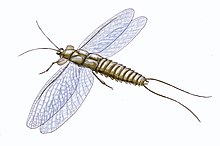| Mazothairos Temporal range: 309 Ma PreꞒ Ꞓ O S D C P T J K Pg N ↓ | |
|---|---|

| |
| Speculative reconstruction of Mazothairos enormis | |
| Scientific classification | |
| Domain: | Eukaryota |
| Kingdom: | Animalia |
| Phylum: | Arthropoda |
| Class: | Insecta |
| Order: | †Palaeodictyoptera |
| Family: | †Homoiopteridae |
| Genus: | †Mazothairos Kukalová-Peck & Richardson, 1983 |
| Species: | †M. enormis |
| Binomial name | |
| †Mazothairos enormis Kukalová-Peck & Richardson, 1983 | |
Mazothairos (from Mazo, derived from its location of Mazon Creek and θαιρός, thairos, meaning 'hinge' in Greek) is an extinct genus of very large insect that lived during the Carboniferous period. It was a member of the order Palaeodictyoptera. Although it is only known from very fragmentary remains from a single fossil, it is estimated to have had a wingspan of around 56 centimeters (22 in), making it one of the largest-known insects, only being rivaled in size by the largest members of the order Meganisoptera, such as Meganeura and Meganeuropsis.
It is the largest known member of the order Palaeodictyoptera, a group of insects characterized by their distinctive beak-like mouthparts, which possibly had a sucking pump-like organ that might have been used to pierce plant tissues and drink their liquids. The group is also known for the pair of winglets on the prothorax in front of the first pair of wings of its members, which gave them the epithet of "six-winged insects".
The Holotype fossil of Mazothairos was found in the Mazon Creek fossil beds in modern-day Illinois, a lagerstätte formed approximately 309 million years ago during the Pennsylvanian epoch of the Carboniferous period, which is thought to have been a part of a river delta system and have had a tropical climate.
See also
References
- ^ Kukalová-Peck, Jarmila; Richardson, Eugene S. (1983). "New Homoiopteridae (Insecta: Paleodictyoptera) with wing articulation from Upper Carboniferous strata of Mazon Creek, Illinois". Canadian Journal of Zoology. 61 (7): 1670–1687. doi:10.1139/z83-218.
- Doell, H.V; Doyen, J.T; Purcell, A.H (1998). Introduction to Insect Biology and Diversity (2nd ed.). Oxford University Press. p. 321. ISBN 0-19-510033-6.
- Parzer, Harald; Stansbury, Matthew (22 October 2018). "Enriching Undergraduate Entomology Coursework through the Integration of Evolutionary Developmental Biology". The American Biology Teacher. 80 (8): 561–569. doi:10.1525/abt.2018.80.8.561. S2CID 92618669.
- Tomoyasu, Yoshinori (January 2018). "Evo–Devo: The Double Identity of Insect Wings". Current Biology. 28 (2): R75 – R77. doi:10.1016/j.cub.2017.12.004. PMID 29374449.
- Elias-Neto, Moysés; Belles, Xavier (3 August 2016). "Tergal and pleural structures contribute to the formation of ectopic prothoracic wings in cockroaches". Royal Society Open Science. 3 (8): 160347. Bibcode:2016RSOS....360347E. doi:10.1098/rsos.160347. PMC 5108966. PMID 27853616.
- Tomoyasu, Yoshinori; Wheeler, Scott R.; Denell, Robin E. (February 2005). "Ultrabithorax is required for membranous wing identity in the beetle Tribolium castaneum". Nature. 433 (7026): 643–647. doi:10.1038/nature03272. PMID 15703749. S2CID 4336906.
| Taxon identifiers | |
|---|---|
| Mazothairos | |
This prehistoric insect-related article is a stub. You can help Misplaced Pages by expanding it. |
This article related to a Carboniferous animal is a stub. You can help Misplaced Pages by expanding it. |